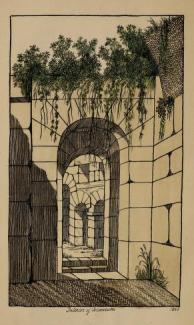The Internet Archive Book of the Week highlights a book from the 25,000 Fisher items that are freely available on the Internet Archive.
This week, Victoria Bowen introduces us to a book from the Biodiversity Collection.
The winter months sometimes seem to be exemplified by trudging slush-filled streets, under never-ending gray skies. Darkness comes early, the wind whips bitterly, and the weather is frigid. These mid-winter attributes lend themselves well to fantasizing about being anywhere else. While travel might be unattainable right now, one way we can experience different circumstances is through diving into various types of media, especially books. One text that can transport us to a different country - and historical period - is Flora of the Colosseum of Rome, or, Illustrations and descriptions of four hundred and twenty plants growing spontaenously upon the ruins of the Colosseum of Rome.
Written by Richard Deakin, and published in London by Groombridge and Sons in 1855, this book primarily contains a catalog of plants growing in and around the Colosseum in the mid-ninteenth century. The text begins with a brief history of the Colosseum, however Deakin quickly informs the reader that history is not his intended subject, and he will instead be focusing on the flora which adorns the ancient ruins. The author shares that he is not the first person to undertake a project of this sort, and credits Roman botanist Antonio Sebastiano's 1815 catalog of 261 plants as his inspiration. Deakin reflects, rather sourly, that he feels a significant amount of species are missing from his work, due to restoration projects occurring at the historic site which destroy naturally occurring greenery. Deakin speaks rather poetically about the connection he sees between flowers and the passage of times, stating:
"They form a link in the memory, and teach us hopeful and soothing lessons, amid the sadness of by-gone ages: and cold indeed must be the heart that does not respond to their silent appeal; for (...) they tell of that regenerating power which reanimates the dust of moldering greatness, and clothe their sad and fallen grandeur with graceful forms." (vi)

The majority of the book concerns itself with thoroughly cataloging the plants of the Colosseum. Deakin organizes the plants under their scientific orders for the ease of study by students and scientists. For those who are less familiar with plant anatomy, there is an alphabetized index located in the back of the book. Regardless of the reader's point of access, be they a lay person or a botany enthusiast, the entries about each plant are very accessible. Each contains descriptions of physical attributes and measurements, the plant's name in Latin and English, when it blooms, as well as a short paragraph providing additional information on the species. This less structured aspect occasionally includes famous poetry which references the plant, or Deakin's own philosophical musings.
Interspersed throughout the text are full page illustrations of specific plants, as well as depictions of sections of the Colosseum. These additions allow the reader to imagine themselves walking through the Colosseum themselves, and happening upon these small instances of nature.
Flora of the Colosseum of Rome may not replace the joys of visiting places like the Colosseum first hand, but it can act as a time capsule, to a different era and a different continent. Deakin's book is a great way to pique your imagination, and a fantastic jumping off point for further exploration.
- Victoria Bowen, TALint Student